Ever thought of bringing that cozy, charming English garden feel to your backyard?
With the right English garden ideas, you can create a stunning outdoor retreat, even with a small patio or big yard.
Whether you’re dreaming of a romantic garden or just want to refresh your backyard, these charming English garden ideas will give you plenty of inspiration to start small and grow big.
English gardens mix order and wildness. They can be full of colorful flowers or neat and tidy. There’s a style for every taste and yard size.
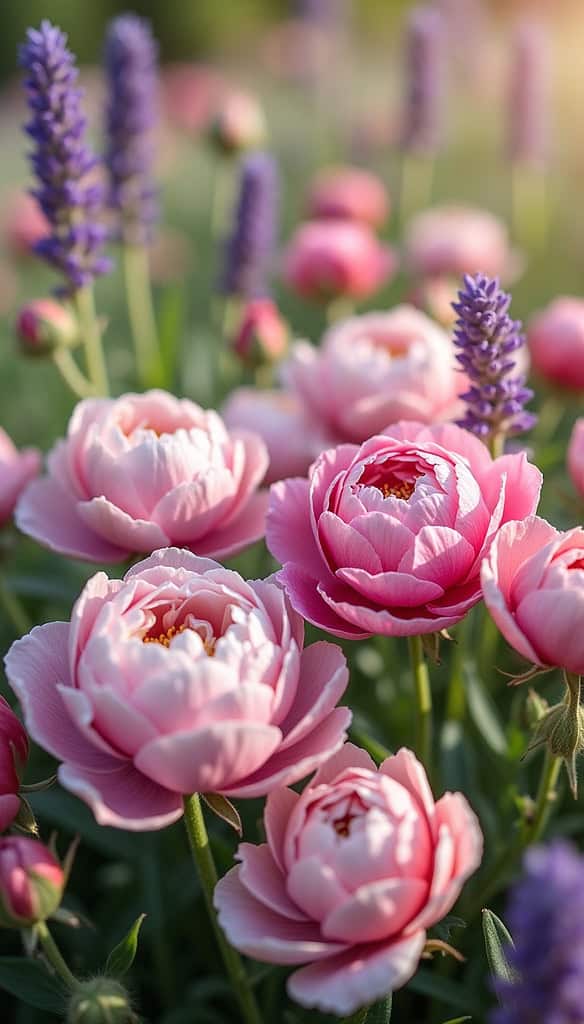
Key Takeaways
- English gardens blend structure and natural beauty
- Variety in plant heights and colors creates visual interest
- Meandering paths enhance accessibility and maintenance
- Dense planting achieves a lush, cottage-style appearance
- Architectural elements define the garden layout
- Drought-tolerant plants are increasingly important
- Water features can increase garden biodiversity
1. Why English Gardens Are So Timeless and Charming
English style gardens have won hearts for centuries. They mix formal looks with wild beauty. These gardens show off nature’s beauty and add charm to any yard.
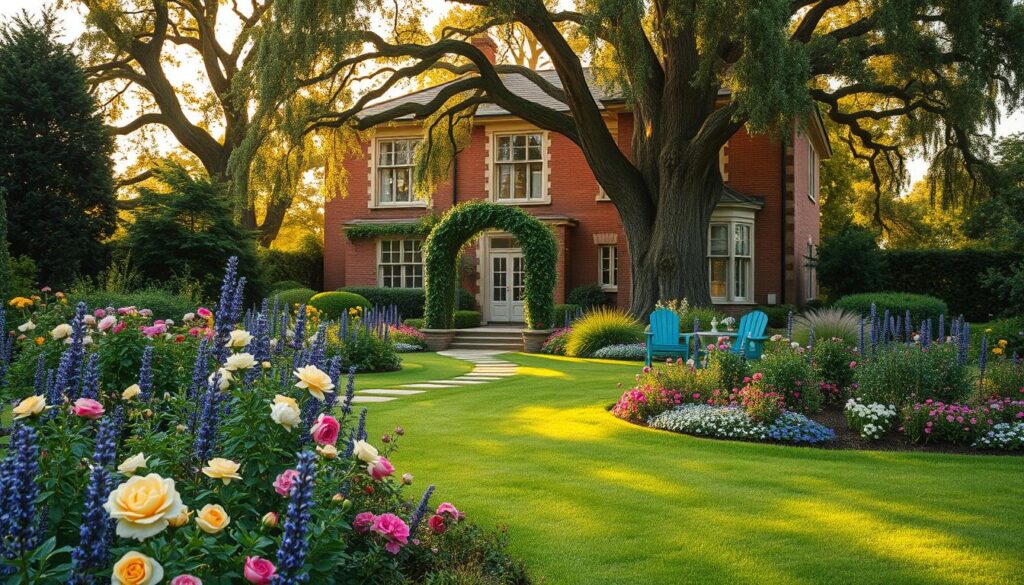
Signature Elements of English Gardens
English garden ideas blend formal and wild parts. Central paths lead to organic shapes, creating balance. Key features include:
- Lush flower beds with perennials, annuals, and biennials
- Winding gravel paths inviting exploration
- Well-maintained lawns as a foundation
- Clipped hedges and topiaries for structure
- Water features like ponds or fountains
Adding Character to Your Yard
One of the best things about English garden design is how it transforms your yard into a cozy retreat.
Picture this—fragrant roses, lavender, and jasmine filling the air while you relax on a stone bench tucked into a quiet garden nook.
Sounds dreamy, right?
Classic stonework and rustic benches add a timeless feel. They help define areas in the garden.
Versatility for All Spaces
English style gardens fit any yard, big or small. In small spaces, use containers and vertical elements to save room.
Larger areas can have big lawns, winding paths, and large water features.
The secret is mixing formal parts with wild, romantic plants. This captures the essence of an English garden.
2. English Garden Design Ideas
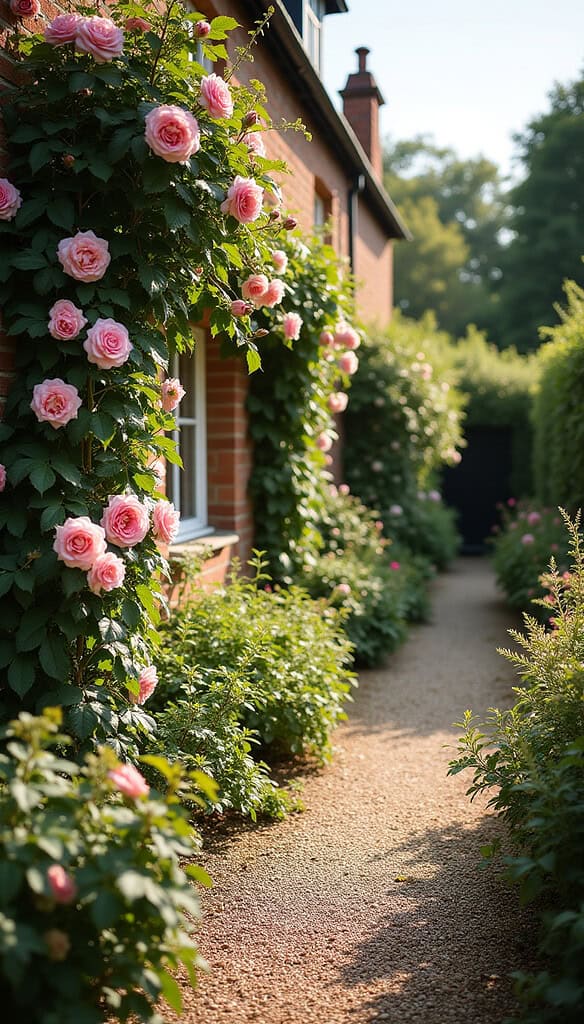
The best English garden ideas also mix structure with nature for beautiful outdoor spaces.
These gardens have both formal parts and wild, romantic areas.
Here are some ideas to help you create your english garden.
Key Elements of Classic English Gardens
Classic English gardens have some special features:
- Lush, densely planted beds
- Low evergreen hedges like boxwood
- Diverse mix of annuals, perennials, and shrubs
- Kitchen gardens with herbs and vegetables
- Winding pathways for exploration
- Climbing roses on walls and trellises
- Fragrant flowers like sweet peas and peonies
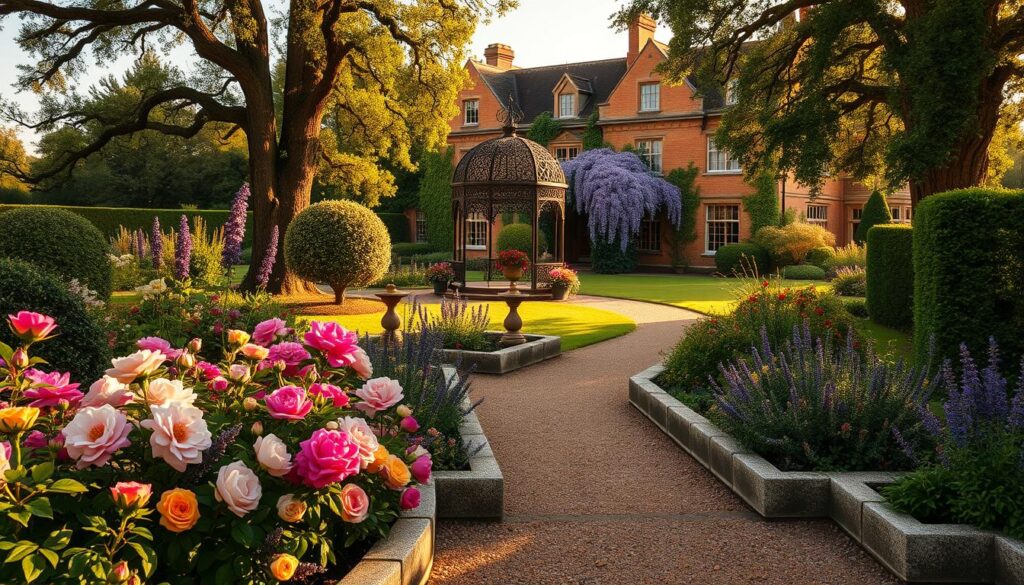
Incorporating Structure and Natural Beauty
To make a real English garden, mix structure with wild beauty:
- Use geometric pathways and symmetrical plantings for formality
- Allow plants to spill over paths for a relaxed look
- Include old-fashioned flowers like delphiniums and hollyhocks
- Add garden benches for enjoying the scenery
- Plant spring bulbs like crocuses and daffodils
- Maximize space with dense plantings, even in small areas
- Incorporate water features to enhance tranquility
By mixing these elements, you can make a beautiful English garden in your backyard.
3. Cottage Garden Inspiration
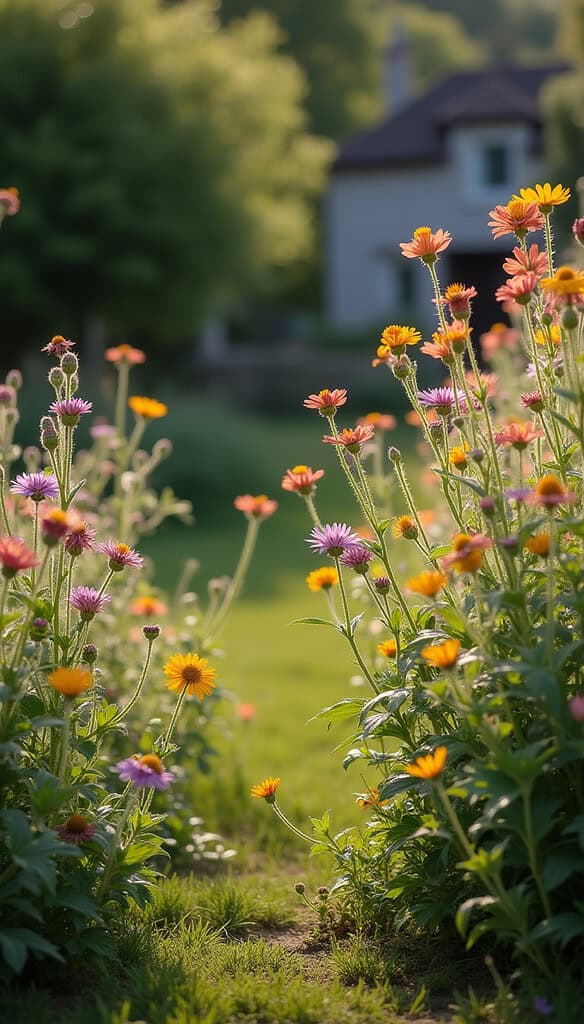
I’ve always dreamed of creating a cozy english cottage garden. When I got the chance, I was thrilled! Let me share some cottage garden ideas that worked wonders for me.
Creating a Cozy and Overflowing Floral Look
My secret? Embrace the chaos! I mixed roses with daisies, lavender, and foxgloves. The result? A riot of colors and scents that brings joy every time I step outside. Don’t worry about perfect placement – let plants spill onto paths for that carefree charm.
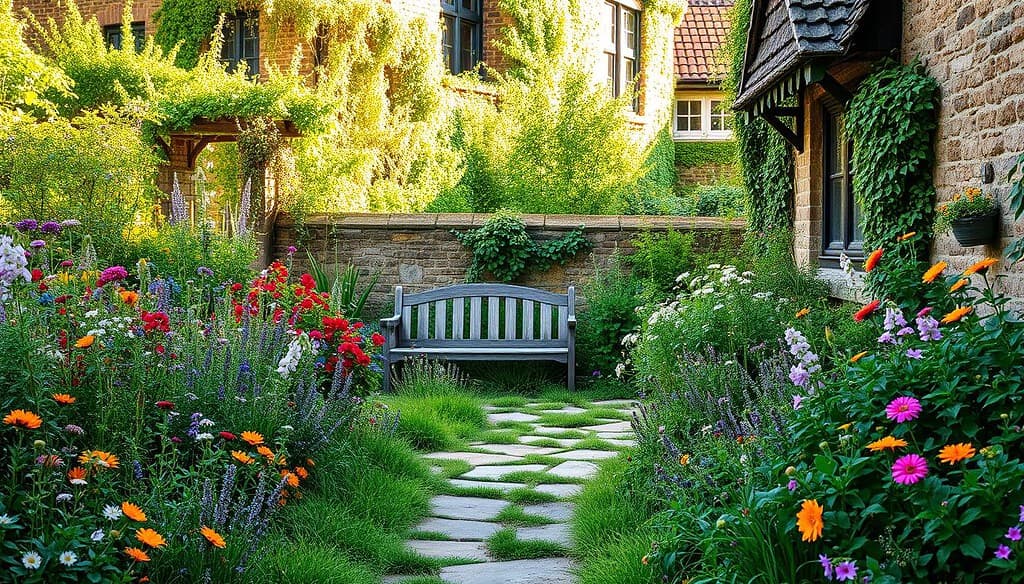
I incorporated curved designs and winding paths, adding rustic fences and stone walls for that authentic feel. Did you know that 30% of homeowners use pathways to enhance their garden’s accessibility and beauty? It’s a game-changer!
👉 Try This: Add a wooden garden arbor to frame your entrance or create a cozy sitting nook. Look for one with climbing rose support to complete the cottage vibe — you can find great options on Amazon that are surprisingly affordable.
Must-have Flowers for an Enchanting Cottage Garden
Here are some flowers that’ll help you create that magical cottage garden vibe:
- Roses: Climbing varieties add vertical interest
- Lavender: Fragrant and versatile
- Foxgloves: Tall and dramatic, perfect for layering
- Daisies: Cheerful and easy to grow
- Hollyhocks: Tall spires of colorful blooms
Mix annuals and perennials for year-round interest. Fun fact: 70% of cottage gardens use this technique to ensure continuous blooming. Remember, a diverse flower arrangement can attract up to 50% more beneficial insects to your garden!
| Garden Feature | Popularity | Benefit |
|---|---|---|
| Arbors | 60% of gardens | Vertical space for climbing plants |
| Birdbaths | 25% of gardens | Attracts birds, promotes biodiversity |
| Water features | 40% of gardeners prefer | Increases garden attractiveness |
4. Traditional English Garden Styles
English gardens have many styles, each unique. They range from formal to country gardens. Let’s look at these classic styles and how to pick the best one for your yard.
Formal English Gardens
Formal English gardens are neat and structured. They have:
- Symmetrical flower beds
- Carefully placed statuary
- Elegant fountains
- Manicured hedges
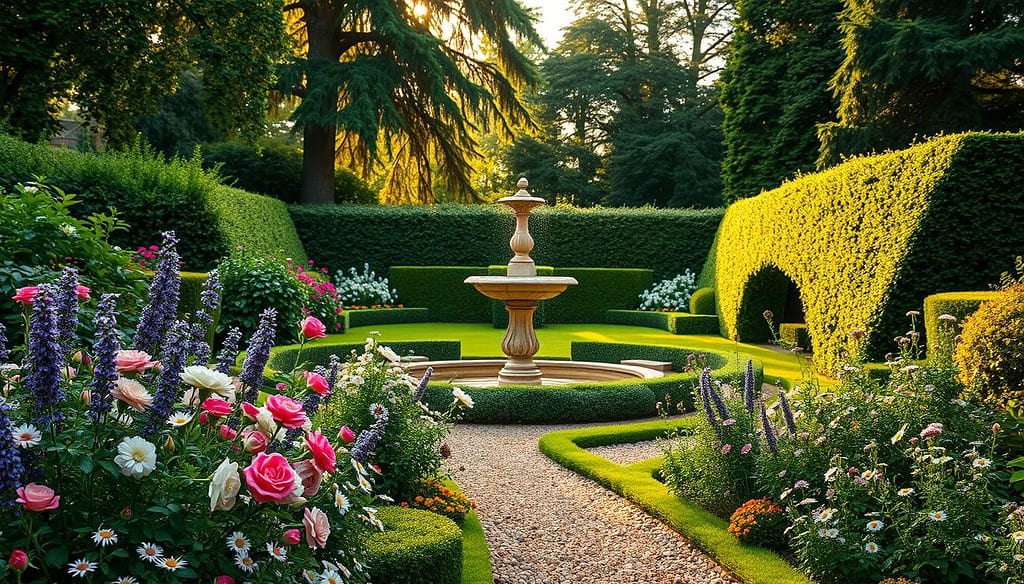
English Country Gardens
English country gardens are cozy and natural. They mix structure with beauty. Key features are:
- Overflowing flower beds
- Winding pathways
- Cottage-style plants
- Rustic decorative pieces
Choosing Your Style
Think about your yard’s size, sunlight, and how much time you have to care for it. Formal gardens need more work and are for bigger yards. Country gardens are easier to care for and fit smaller yards.
Start small and add more as you go. With time and effort, you’ll have a beautiful garden. It will show the timeless beauty of English garden styles.
5. Small English Garden Ideas
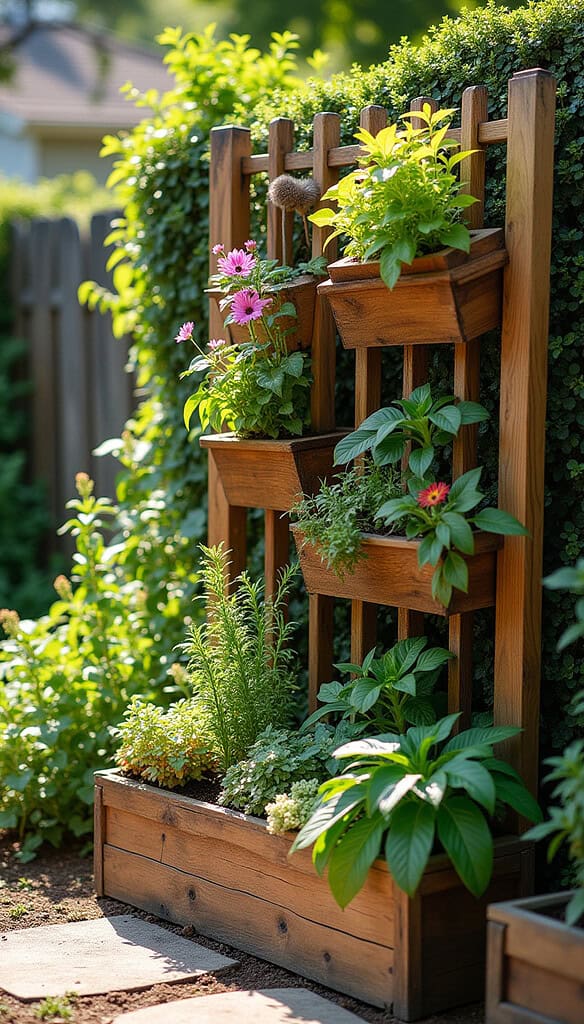
Think you need a huge yard for a gorgeous English garden? Nope! Even the tiniest outdoor space can feel lush and inviting with the right tricks. Let’s look at simple ways to create a small but stunning English garden!
Space-Saving Techniques for Compact Yards
Vertical gardening is key in small areas. Use trellises, wall planters, and climbing plants to save space. Raised beds also help, adding depth and making the area seem bigger. For a true English garden feel, try these:
- Espaliered fruit trees against walls or fences
- Hanging baskets filled with colorful annuals
- Container gardens for flexible planting options
- Dwarf varieties of classic English shrubs
Using Layers and Focal Points to Maximize Space
Layering is a key English garden technique for small spaces. Start with tall plants at the back and get smaller towards the front. This makes the garden look lush and interesting. Here are some layering tips:
- Use trees for height, shrubs for structure, and perennials for color
- Plant in drifts of 3 to 5 for a cohesive look
- Incorporate evergreens for year-round appeal
Focal points make small gardens feel bigger. A charming water feature, ornate bird bath, or classic stone statue can be a beautiful centerpiece. In small English gardens, every plant and element should work together, making the garden welcoming.
6. English Cottage Garden Plants
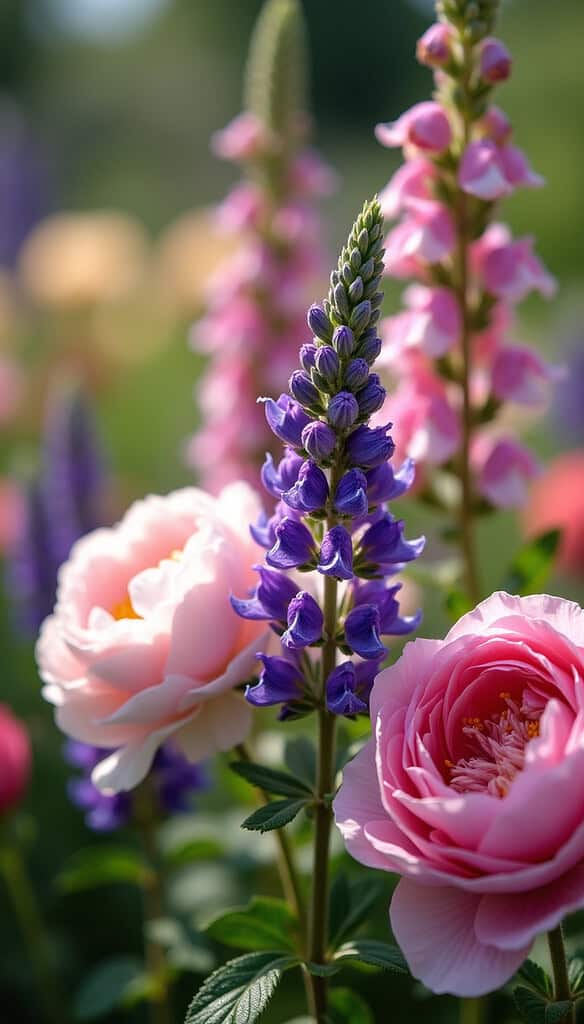
To make your garden look like an English cottage, pick the right plants. English garden plants are key to these lovely spaces. Let’s look at some popular picks for a cozy, lush yard.
Best Plants for Your English Garden
For an English garden, choose many different plants. Roses add beauty and smell. Lavender smells nice and helps bees. Foxgloves add height and drama. Here are some top picks:
| Plant | USDA Zones | Mature Size | Sun Needs |
|---|---|---|---|
| Roses | 3-11 | 3-5 ft (shrubs), up to 11 ft (climbing) | Full sun |
| Lavender | 5-10 | 2 ft tall, 1-2 ft wide | Full sun |
| Foxglove | 4-9 | 2-5 ft tall, 1.5 ft wide | Full sun to part shade |
| Peonies | 3-8 | 1-3 ft tall and wide | Full sun |
👉 Get the Look: Want those signature spires of color? These foxglove flower seeds are perfect for beginner gardeners and blend beautifully with other English favorites like roses and peonies.
Companion Planting for a Lush Look
Companion planting makes your garden better. Put tall plants like delphiniums with short ones like alyssum. Marigolds near veggies keep pests away. Add plants like yarrow or sedum for less work.
English garden plants bloom for a long time. Coreopsis and gaillardia keep colors going. Hellebores add interest in winter. Mixing plants by height, texture, and bloom time makes a beautiful garden that helps wildlife.
7. Romantic Garden Design Ideas
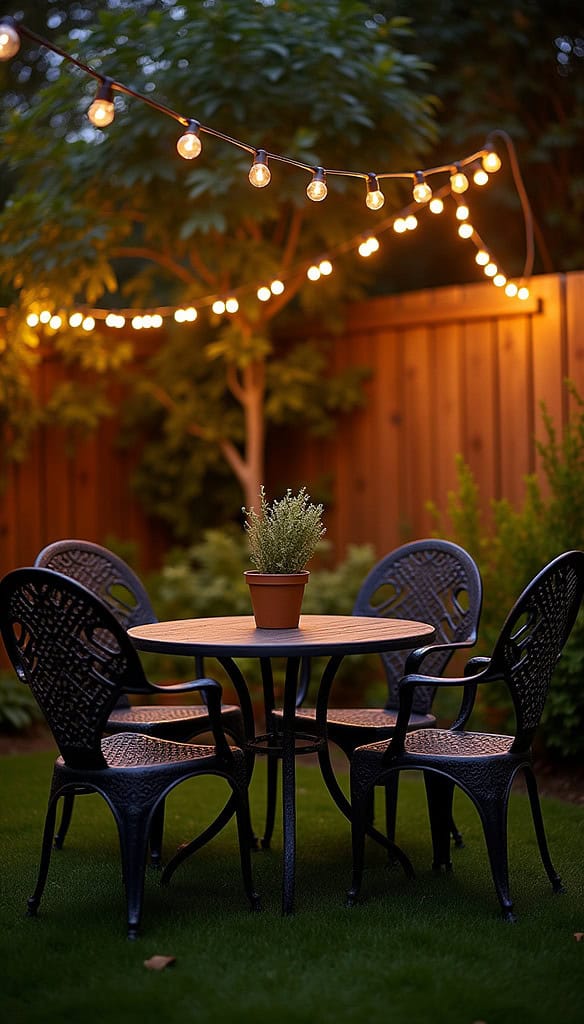
Want to make your yard a dreamy oasis? Let’s look at some romantic garden ideas. English rose gardens are great for this style.
Adding Whimsical Elements
Begin with soft, curving lines in your garden. Use paths that wind to add mystery. A Victorian ‘heart’ gate can be a beautiful centerpiece.
For a magical feel, hang solar fairy lights. They shine softly at night.
Soft Colors and Fragrant Flowers
Choose soft pastels for your garden. Pinks, peaches, and whites are calming. ‘Lover’s Meeting’ roses bloom for nine months, adding beauty.
Use plants like lavender and foxgloves for texture. They add depth.
Don’t forget scent in your garden. Roses, jasmine, and sweet peas are great. A single scent can make your garden unforgettable.
Vintage Touches
Add vintage decor for romance. Find wrought iron chairs at antique markets. They’re often $20 each.
If you want the look without the hunt, there are some gorgeous wrought iron benches available online.
👉 Get the Look: Try this elegant vintage-style garden bench to bring a timeless touch to your backyard seating area.
Use faded cushions and old rugs for cozy spots. These details make your garden unique.
8. Classic English Flower Garden
Creating a classic English flower garden adds timeless charm to your yard. These gardens are full of colors and lush plants. They bring natural beauty and calm to your space. Let’s look at how to design a stunning English garden that will impress your neighbors.
Creating a Vibrant Oasis
To get that classic English garden look, focus on plant density and variety. Mix annuals, perennials, and shrubs for a colorful mix. Include roses, delphiniums, foxgloves, and lupins. These plants add beauty and attract helpful wildlife.
Color-Coordinated Planting for Cohesive Design
A good color scheme is essential for a harmonious garden. Pick colors that match your home and style. Plant in groups for a strong look. Use spring bulbs like daffodils and tulips for early color, then summer bloomers like peonies and sweet peas. Add fragrant flowers for a better experience.
| Season | Recommended Flowers | Color Palette |
|---|---|---|
| Spring | Tulips, Daffodils, Foxgloves | Pastels, Yellows, Purples |
| Summer | Roses, Delphiniums, Lavender | Pinks, Blues, Purples |
| Fall | Dahlias, Asters, Chrysanthemums | Deep Reds, Oranges, Golds |
A classic English garden looks best when it’s a bit wild. Let plants like poppies grow on their own. Follow these tips to make a vibrant and beautiful English garden. It will be a peaceful spot all year.
9. English Country Garden Decor
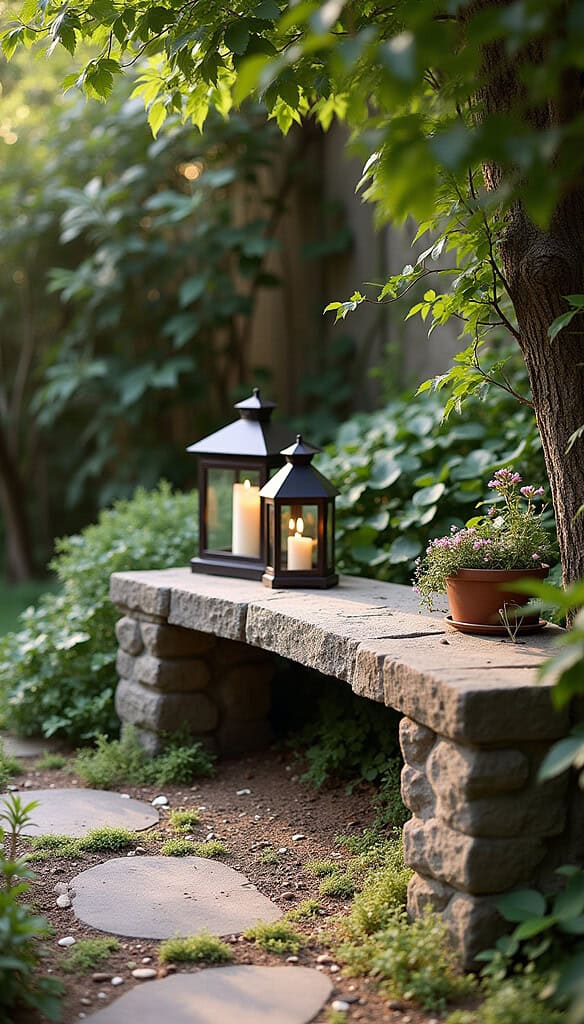
English country garden decor makes your outdoor space charming. It mixes rustic and elegant elements for a timeless look. Let’s look at some key decorative elements to make your yard cozy.
Charming Decorative Elements
Benches are key in english country garden decor. Put a weathered wooden bench under a flowering arbor or near a pond. It’s a perfect spot. Antique wrought-iron seating adds elegance.
Rustic and Vintage Pieces
Use rustic elements for an authentic feel in your garden. Old wooden gates or stone walls make great boundaries. Use vintage items as planters, like old wheelbarrows or watering cans.
- Weathered wooden arbors
- Antique sundials
- Wrought-iron plant stands
- Vintage lanterns for evening ambiance
👉 Get the Look: These hanging solar lanterns bring that vintage English charm after dark — clip them onto an arbor, a shepherd’s hook, or tree branches to light your garden naturally.
The secret to english country garden decor is a lived-in feel. Mix different pieces and embrace imperfections. Let your garden tell a story through its decor.
10. Low-Maintenance English Garden
Creating a low-maintenance english garden is easy. You can have a beautiful garden without spending too much time on it. Let’s look at some smart choices to make your garden look great with little effort.
Drought-Tolerant and Hardy Plants
Choose plants that need less care. Lavender, yarrow, and Russian sage are great choices. They look beautiful and need less water and attention.
Hardy shrubs and evergreens are also good. They don’t need to be replaced every year.
Smart Landscaping Choices
Think differently about your garden layout. Replace lawns with gravel gardens or wildflower meadows. This saves a lot of mowing time.
Use big pots for plants. They keep moisture in longer and need less water.
Here’s a table showing some low-maintenance gardening tips:
| Strategy | Benefit | Maintenance Reduction |
|---|---|---|
| Mulching | Retains moisture, suppresses weeds | Up to 50% less watering needed |
| Groundcover plants | Suppress weeds | Reduces weeding by 70% |
| Permanent lawn edges | Simplifies lawn care | Cuts edge trimming time by 80% |
| Self-clinging climbers | Utilizes vertical space | Reduces horizontal planting needs by 30% |
By using these tips, you can have a beautiful english garden with less work. Remember, natural imperfections can make your garden more charming. This way, you can enjoy your garden more without worrying about upkeep.
11. Charming Garden Pathways
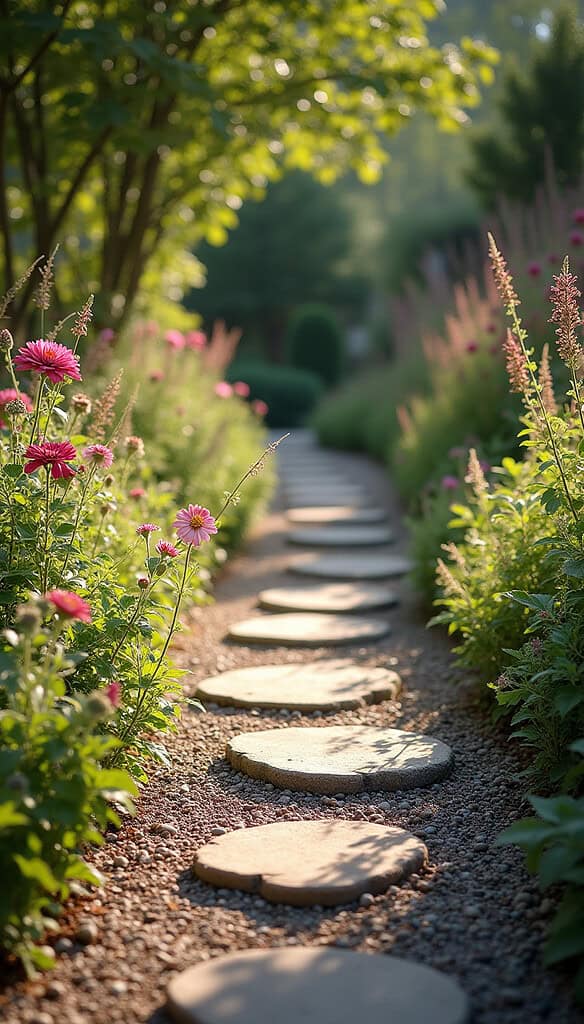
Garden pathways are the heart of English garden landscaping. They guide visitors through your outdoor oasis, inviting exploration and discovery. Let’s dive into the world of charming garden pathways and how they can transform your space.
The Magic of Meandering Paths
In English gardens, paths aren’t just functional – they’re an experience. Curved pathways create a sense of mystery and encourage slow wandering. This design choice aligns perfectly with the relaxed, romantic feel of English gardens.
Popular Materials for Garden Paths
Gravel is a favorite for English garden pathways. It’s budget-friendly, easy to install, and adds a satisfying crunch underfoot. For a more formal look, consider brick or flagstone. Natural stepping stones set in grass offer a seamless blend with the landscape.
- Gravel: Low-cost, easy to maintain
- Brick: Durable, classic appearance
- Flagstone: Natural look, can be combined with grass
- Stepping stones: Creates a whimsical path through grass or groundcover
Remember, the key to charming garden pathways is variety. Mix materials to create interest and define different garden areas. A gravel path might lead to a wooden bridge over a small pond, then transition to stepping stones through a wildflower meadow.
When planning your English garden landscaping, think beyond just getting from point A to B. Your paths should invite strolling, pausing, and admiring the beauty around you. With the right design, your garden pathways will become an integral part of your outdoor sanctuary.
12. Final Thoughts on Creating Your Own English Garden
Bringing these English garden ideas to life doesn’t have to be complicated. Start with a few simple changes—like adding climbing roses, a winding path, or a cozy bench—and watch your garden transform! Have your own English garden tips? Drop them in the comments—I’d love to hear!”
If you’re in the Pacific Northwest, there are plenty of great plant options to choose from. Start with roses, lavender, and hydrangeas—these bloom for months and attract bees and butterflies. Hellebores and hen-and-chicks are also great picks because they’re hardy and low-maintenance.
As your garden grows, mix in plants with golden leaves and bright annuals to keep things colorful all season long. You can even turn part of your lawn into a wildflower meadow for a greener, more sustainable look. Self-seeding flowers like poppies are a great way to add variety with minimal effort.
“I’d love to see your English garden ideas come to life! Share your favorite plants and designs and join our community who love bringing a bit of England to their yards.







